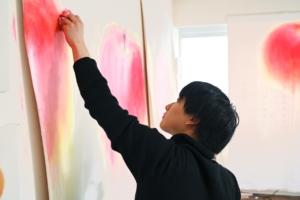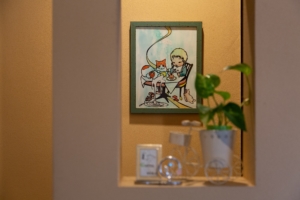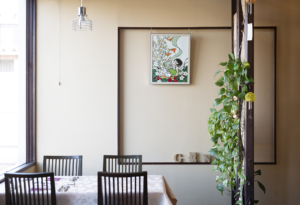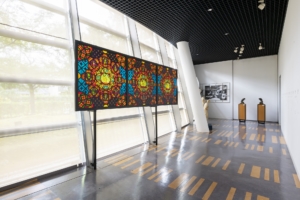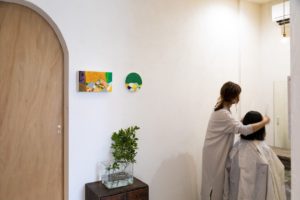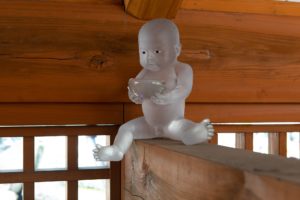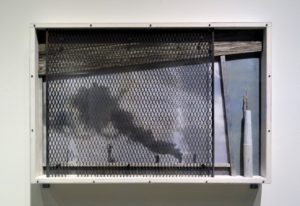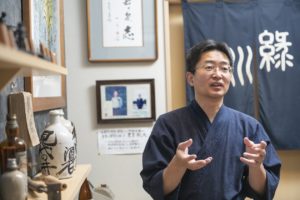There is a mural that remains in my memory. The mural has not lost its vividness after nearly half a century.
The mural is the work of Ay-O, a Japanese contemporary artist. I was interested in the background of the mural. So, I interviewed people at Special Support School to University of Fukui (Japan), where the mural was installed.
The interview revealed that the mural was an expression of the school’s founding and philosophy.
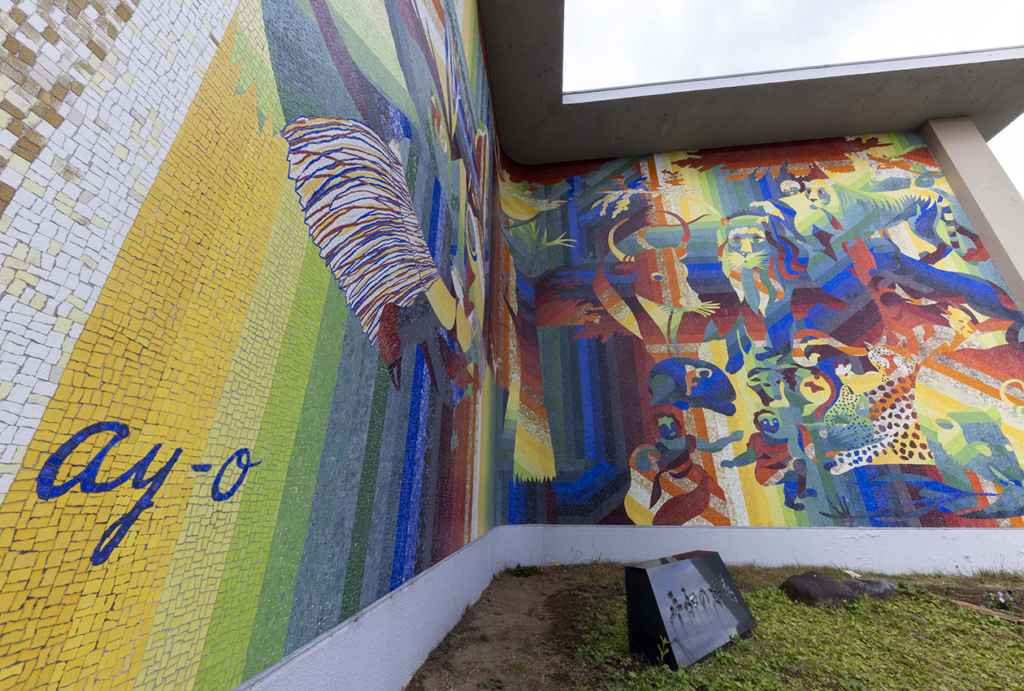
The original picture of the mural was based on Nashville Skyline, one of Ay-O’s representative works. The work consisted of ten prints. Two of the ten prints were adopted as the mural, and were reconstructed as a single mural.
Ay-O is a contemporary artist also known as “artist of rainbow”. There are many collectors of his works in Fukui Prefecture in Japan. SUKEDA Kenryo, who lives in Fukui-shi (Fukui Prefecture), is one of them.
SUKEDA is a printer of Ay-O’s prints, and at Ay-O’s request, he printed the print that were the basis of the mural.
Why did Ay-O chose Nashville Skyline as the subject of that mural?
Ay-O was inspired by the American Naive Painting Exhibition (Nihombashi Mitsukoshi Tokyo, 1970) and made Nashville Skyline.
In that exhibition, there were works from the time when unknown American artists were making simple but attractive paintings.
He was very strongly inspired by that exhibition. He contributed an article about naive art to a Japanese art magazine Mizue (みずゑ) and appealed to readers, “Anyway, let’s throw seriousness out the window.”
Around that time, I received an offer to create a mural for the school. The offer came from Mr. KIMIZU Ikuo, the vice principal of the school at that time.
Mr. KIMIZU was passionate about art education for children, and even encouraged adults to “paint as children paint.”
I guess Ay-O must have sympathized with Mr. KIMIZU’s work, and I also guess that both Ay-O and Mr. KIMIZU had a longing for naive art. From these factors, Ay-O may have decided that Nashville Skyline was the best choice.
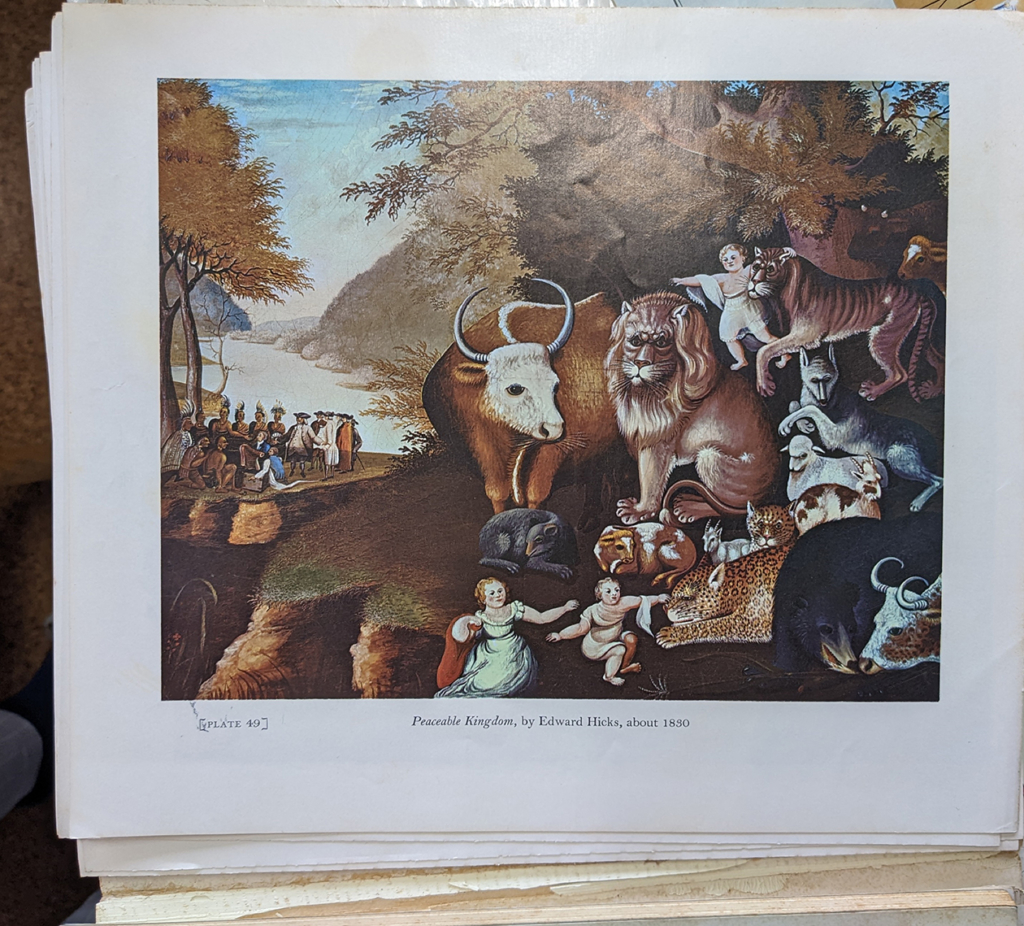
Mr. SUKEDA, do you know how the mural was installed?
It is a very long story to explain. To put it simply, it is based on the ideas of Mr. KIMIZU, the vice principal of the school. The idea was to “build a school of our own ideal” and “a school should be artistic.”
It was difficult to convince the people around him of the cost and other factors. Overcoming these difficulties, the work was finally completed in 1975 with the involvement of many people.
Was the plan to recreate the Nashville Skyline using tiles planned from the beginning of the project?
At the time, we could find no other way.
In order to implement the work using tiles, we first consulted with Seto ceramic artist HIRAKO Yoshinori. He is a friend of Mr. KIMIZU.
Ay-O, Mr. KIMIZU, and I visited Mr. HIRAKO and asked him to make samples of colored tiles. However, it was difficult to reproduce Ay-O’s ideal rainbow purple in the tiles. I remember that the red color was also difficult.
I guessed that the temperature at the time of firing, the temperature and the quality of the clay affected each other. Thus, in the beginning, it did not go so well.
We also considered other sources of consultation, and consulted with Kindai Mosaic Co. in Tokyo.
The staff at that company showed us a different way to reproduce the colors directly. The idea was to combine ready-made tiles so that the color would appear ideal to Ay-O when viewed from a distance.
This was indeed a realistic approach, and we decided to go with it. We decided to order the work from Kindai Mosaic.
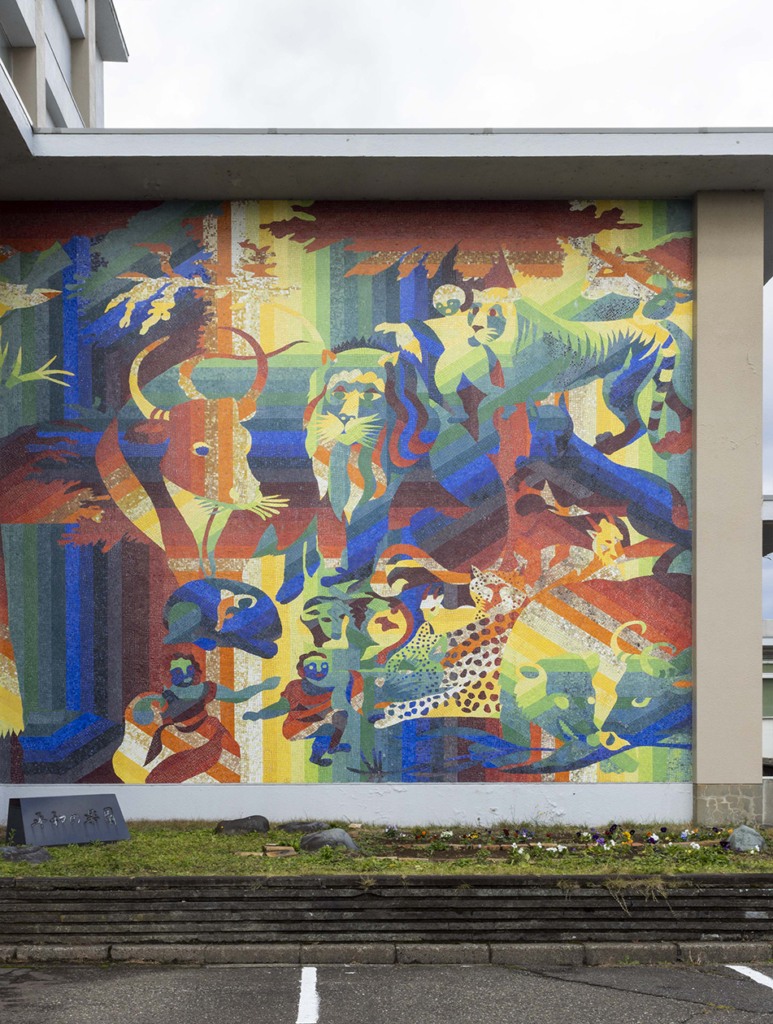
It is still very vivid after 45 years. The tiles don’t seem to be peeling off.
The mural has been burned by the sun, so it’s not exactly as it was. It’s certainly beautiful even now. The reason why the tiles are not peeling off is because the groundwork is solid. Kenji Mizuyachi, the photographer, said, “We have to make the base solid,” so he made it.
After the completion, Ay-O came to see here. I think it was in July of 1975. The children sang welcome songs and organized events, and he was very moved and pleased.
As a printer, what did you think of the completion?
I was overwhelmed by the size of the painting. At the special needs school, education was fostered based on this picture.
As for me, I was proud that the work I was involved in was completed as a wall painting.
To be honest, I am not fully satisfied with the color reproduction of Ay-O’s paintings. However, I believe this is a mural that did the best it could with the technology available at the time, 45 years ago.
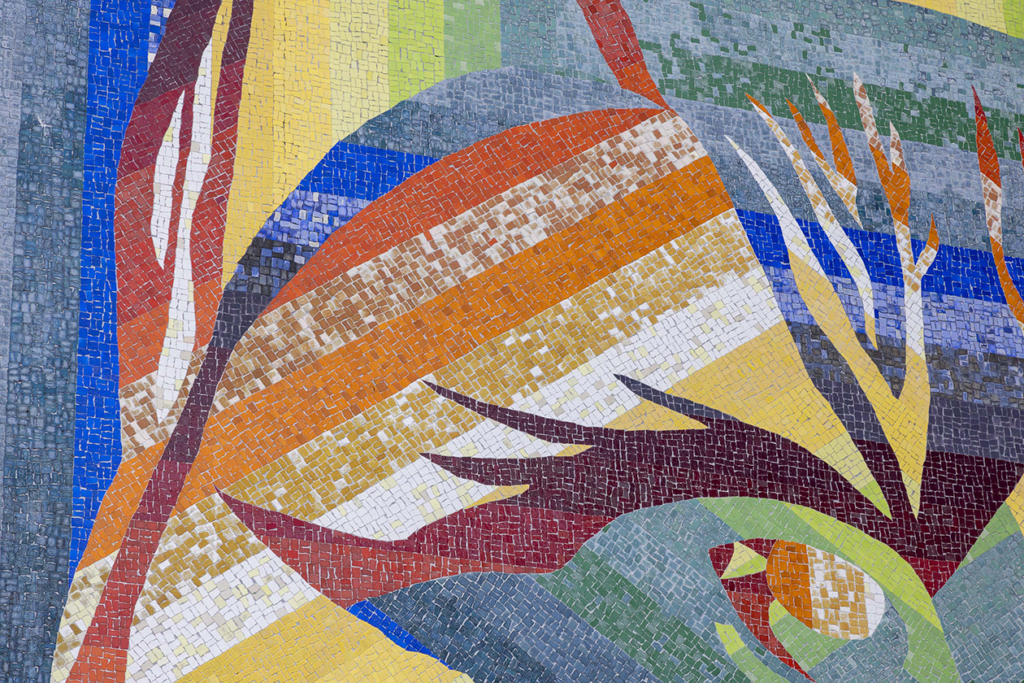
The rainbow is a symbol of respect for diversity. It is a symbol that it is better to have many different things.
I also interviewed a teacher who lived his teaching career with the mural. His name is AMAKATA Kazuya. He was assigned to that school in 1983 and taught there for 37 years.
How did you feel about the school with the mural?
The mural has impact. Simply put, the mural is a visualization of the school’s philosophy and an expression of its educational policy.
It is filled with the thoughts of Mr. KIMIZU, who, as the first vice principal of that school, put a lot of effort into installing the mural. The idea of installing the work outside rather than inside the school building is also bold.
I heard that you also counted the number of tiles in the mural. Are you sure?
It was found that there are 1,600 to 2,000 tiles in a square meter. The mural is approximately 13 meters wide and 6 meters long, thus an area of approximately 78 square meters, which means that 124,800 to 156,000 tiles were used for the entire mural.
I explained to the students how much time and effort it must have taken.
Mr. AMAKATA, what are your memories of Ay-O?
In 2010, his exhibition was held in Ono Castle (Ono-shi, Fukui, Japan). On that occasion, he visited the school and agreed to have his picture taken with the students in front of the mural.
Please tell me what you feel in front of the mural.
Ay-O, known as the Rainbow Artist, is a symbol of diversity. I sense in his work a message that it is desirable for a variety of people and things to exist in the world.
Paradise of Peace also contains the message of the teachers who have been involved with the school. The message is “Be cheerful, be free, get along with each other, encourage each other, and live joyfully and to the fullest.
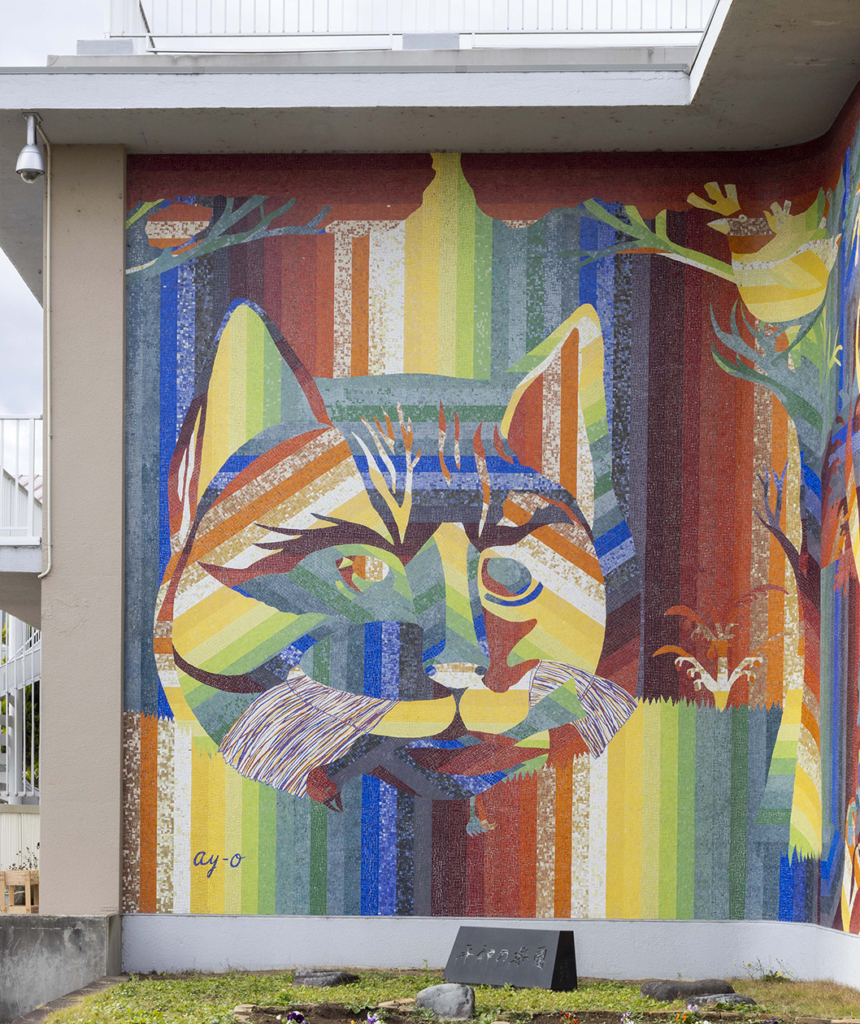
To a school life that is upbeat, smiling, and positive!
How do the teachers and students currently working there feel about the mural? I also interviewed the current vice principal and principal.
MIZUKAMI Shinichi, vice principal of the school, said, “Actually, I came to the school in 2021. I didn’t know about the mural until that time, but when I first came here, I was amazed at how vivid and beautiful it was. Just by looking at it, I can feel excited and think positively,” he said smiling.
YOSHIDA Yaeko, the principal of the school, also responded with enthusiasm.
“Every morning, students walk past this mural to enter the school building. At the athletic festival day, we made the entrance gate based on the animals in the mural.”
In 2021, that school celebrated its 50th anniversary, and although the school’s activities were constrained by the spread of COVID-19, it also held a small celebration.
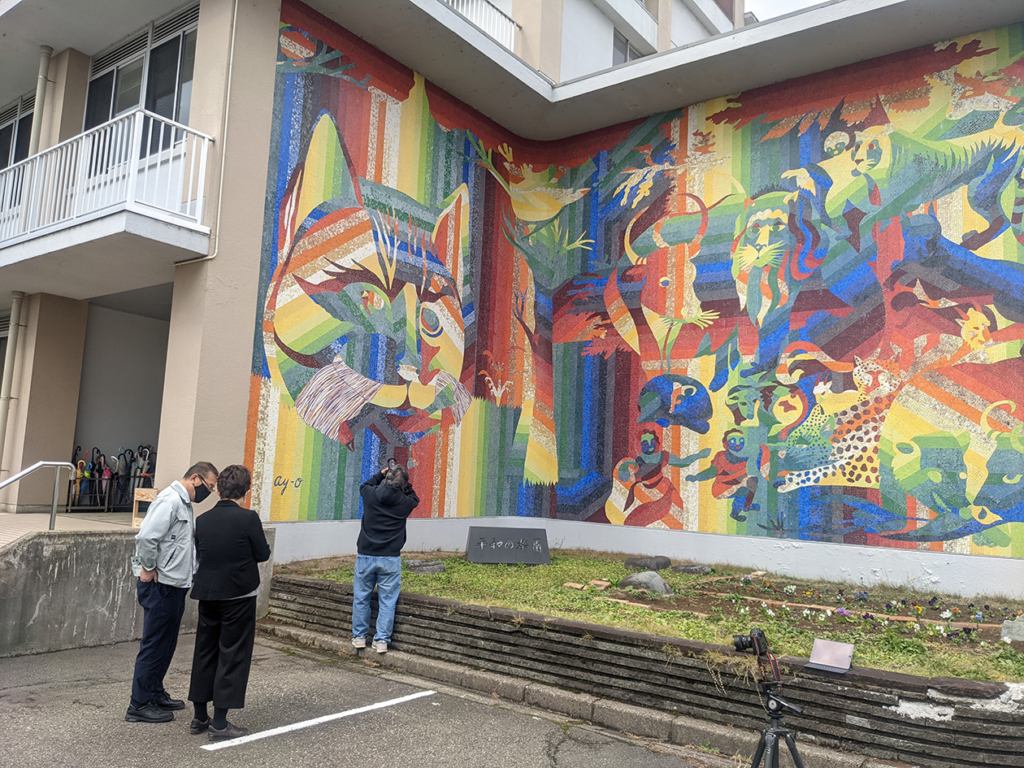
Ay-O Paradise of Peace
Size: 5 meters×11 meters
Hard porcelain colored tiles, mosaic finish
Total cost: 3 million yen (at the time of 1975)
Completion date: March 1975
Special Support School to Fukui University.
1-3 Yatsushima, Fukui-shi, Fukui JAPAN 910-0065
